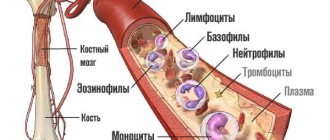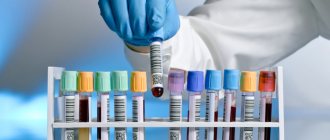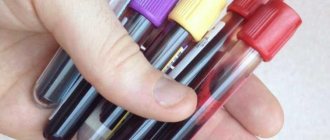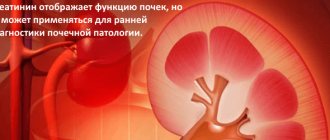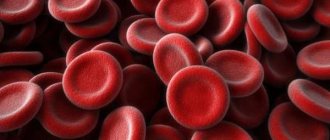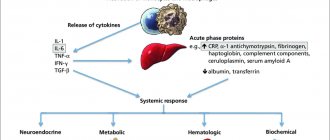5605
Reduced levels of total bilirubin can lead to serious complications. Doctors note that this condition indicates pathological conditions in the body.
Bilirubin is a half-life product of hemoglobin. The substance is responsible for the correct chemical composition of bile produced by the bone marrow and spleen.
Bilirubin is a red-brown bile substance that combines with glucuronic acid. It passes through all the bile ducts, after which it enters the duodenum. The average lifespan of a bilirubin cell is 100 days.
Preparing for the test
In order for the test results to be reliable, a number of simple rules must be followed and some preparation must be done. As with a regular biochemical blood test, when checking bilirubin, you must come to the treatment room early in the morning, on an empty stomach.
- 1 - 2 days before the planned blood draw, you should avoid eating fried and fatty foods so that the liver is not overloaded.
- 2–3 days before the test, you should refrain from playing sports, since intense exercise and stress affect the functioning of the liver. The use of medications should also be limited (about 1 to 2 weeks in advance), since the components they contain can also change indicators, complicating diagnosis.
In some cases, the doctor may prescribe a repeat test with mandatory adherence to a diet for several days, while the nutritional value of the foods consumed should not exceed 500 kcal.
Blood is drawn from a vein. The patient's arm above the elbow is clamped with a tourniquet, after which a vein is pierced with a syringe and the required amount of blood is drawn.
Types of bilirubin
When determining the amount of yellow pigment, the concentration of total bilirubin is initially determined, after which the direct component is determined, and the difference between these indicators is considered the level of the indirect component.
Total bilirubin is usually understood as the entire available volume of this substance in the blood plasma. The indirect type of bilirubin consists of unconjugated and water-insoluble elements. The direct type is a substance that is conjugated and soluble in water.
Each type of bilirubin (direct and indirect) has its own special significance, since it is through the determination of this substance that doctors are able to identify many pathologies in the functioning of not only the liver, but also other systems and organs.
The indirect form of bilirubin is a toxic element, and the liver’s task is to neutralize it, convert it into a direct form, that is, into substances soluble in ordinary water, with which bilirubin is excreted from the body. If the level of this substance in the patient’s blood is elevated, he develops characteristic “icteric” signs: yellowing of the skin, dryness and itching, toxicosis.
Reasons for elevated readings
Bilirubin is higher than normal in diseases of the liver tissue:
- hepatitis due to alcoholism, infectious mononucleosis, poisoning, including medicinal (paracetamol, isoniazid), poisonous mushrooms;
- fatty hepatosis;
- tumor or metastases;
- purulent focus (abscess);
- cirrhosis;
- heart defects or pulmonary diseases with circulatory disorders and blood stagnation (right ventricular failure).
The cause of the increase is blockage of the bile ducts:
- thickening of bile, stones in the ducts;
- inflammation – cholangitis, cholecystitis;
- compression by a tumor or edematous head of the pancreas, duodenum;
- scar changes after chronic inflammation;
- congenital structural anomalies;
- echinococcosis (parasitic disease).
Cholangitis
Excess bilirubin in the blood occurs when there is an increased supply of bilirubin from destroyed red blood cells against the background of:
- hemolytic anemia;
- deficiency of vitamin B12 and folic acid;
- thalassemia (hereditary change in red blood cells);
- malaria;
- trauma and extensive hemorrhages;
- sepsis (infectious blood poisoning).
Rare causes of disorders of bilirubin metabolism are familial forms of enzymopathies, that is, deficiency of enzymes involved in the binding of indirect bilirubin. These include Gilbert's, Rotor's and a number of other congenital diseases.
Watch this video about the causes of increased bilirubin:
The norm of total bilirubin in the blood of women by age
The average normal pigment value is considered to be from 3.5 to 20.5 µmol/l. Of course, reference data is of decisive importance, so doctors mainly focus on them.
If the values of bilirubin in the blood are higher than the specified norm, then in some cases they are not considered a violation. The content of this indicator may be higher if a woman has any disturbances in the functioning of the gastrointestinal tract.
Various conditions, for example, the menstrual cycle, pregnancy, can distort the accuracy of the results of blood tests for bilirubin obtained in women.
As a rule, in the initial phase of the menstrual cycle, many women experience a slight increase in this component, but after the end of planned bleeding, everything quickly returns to normal. Indications also change with age. Increased bilirubin can be detected in the presence of hepatitis C in a chronic form, exacerbation of gastrointestinal diseases.
In newborns, levels of yellow pigment in the blood are always quite high, but only in the first days after birth. After the first week of their life, the bilirubin level is established and returns to normal.
Reasons for decreased bilirubin
In a normal and healthy person, there is from 3 to 15 µmol/l in the blood. Immediately after birth, the child lacks this pigment; it appears only at 4-5 weeks of life. The amount of bilirubin does not depend on gender. Statistics show that this figure is usually lower in women. The following reasons can provoke a decrease in this pigment in the blood:
- Kidney failure - this organ does not perform the necessary functions, which is why toxins entering the blood destroy bilirubin. This is usually a chronic pathology, but it can also occur against the background of a long-term inflammatory process;
- Aplastic anemia is a rare disease of the circulatory system that occurs against the background of autoimmune diseases, radiation, poisoning and toxins;
- Acute leukemia is a disease of the bone marrow when it cannot produce enough red blood cells;
- Nutritional exhaustion is a condition that occurs against the background of an unbalanced diet or during intense physical activity;
- Intoxication due to tuberculosis - usually occurs in adolescents and children who develop tuberculosis. Bacteria interfere with the normal functioning of hematopoiesis.
To prescribe effective treatment for this condition, the doctor needs to determine the exact cause that contributed to the development of the degenerative process.
Otherwise, drug therapy will not be sufficiently effective. In 5% of cases, low bilirubin is diagnosed due to medical error - because of this, all patients undergo re-examination.
Features of deviations from the norms
With age, most women tend to decrease the level of this blood element, which is largely due to the gradual appearance of various ailments that affect the level of pigment formed.
As a rule, women who have given birth by this age have a weakening of the liver, which is caused by the increased load on the organ during the period of gestation. This also cannot but affect bilirubin levels and is not an abnormal deviation. Let us consider in more detail the features of deviations from the norm of total bilirubin in the blood in women after 40, 50, 50 years.
Features of decreased bilirubin levels in adult women:
- In women over 40 years of age, the norm is considered to be from 3.9 to 17.6 µmol/l, which is associated with various liver diseases, as well as disturbances in the digestive system as a whole. Also, deviations considered normal occur during ovulation, during menstruation. The amount of pigment can also be influenced by external factors, for example, climate change, excessively high temperature outside or, conversely, hypothermia.
- The normal level of bilirubin in the blood of women over 50 years of age ranges from 3.7 to 17.4 µmol/l, but sometimes the result may be somewhat underestimated. At this age, women already enter menopause, which causes not only hormonal instability, but also the appearance of many diseases on this basis. All this cannot but affect the level of bilirubin, but, as a rule, deviations are not negative.
- After 60 years, the level of bilirubin in the blood of women, as well as men, may decrease somewhat, since most people of this age develop diseases of the cardiac system. As a result of the lower content of red blood cells in the blood and the decrease in hemoglobin due to these diseases, the level of bilirubin, formed from the destruction of dead red blood cells, also drops.
Causes of low bilirubin levels
A reduced level of bile pigment in the bloodstream (hypobilirubinemia) has important diagnostic significance. In a comparative assessment of the indicators of a general clinical and biochemical blood test, against the background of low bilirubin, erythropenia (reduced concentration of red blood cells) is recorded, as fundamental substances for the formation of pigment.
The causes of low bilirubin are classified into two main groups:
- pathological, associated with dysfunction of internal organs;
- non-pathological, depending on the patient himself.
If the pigment concentration is not standardized, diseases of the kidney system, heart, lung infection, and blood diseases are suspected. The most common pathological conditions include:
Normal level of urobilinogen in urine
- Infection with Koch's bacillus (pulmonary or kidney tuberculosis).
- IHD (coronary heart disease). Characterized by a lack of blood supply to the myocardium. A decrease in bilirubin in the blood is observed in patients aged 60+. A common complication of ischemia is myocardial infarction.
- Dysfunction of bone marrow hematopoiesis (anaplastic anemia, otherwise anemia). The disease is characterized by a violation of the synthesis of blood cells (erythrocytes, platelets, leukocytes).
- Malignant lesion of the hematopoietic system (acute leukemia). It is a form of leukemia (cancer of the bone marrow and blood).
- Partial or complete loss of the kidneys' ability to produce and excrete urine (renal failure). Pathology develops as a complication of chronic diseases of the urinary system, diabetes mellitus, stage III hypertension. It is divided into three main types: prerenal, associated with impaired blood supply to the kidneys, renal, resulting from the destruction of parenchyma (tissue) of organs, postrenal, caused by neoplasms in the urethra (urethra).
In rare cases, congenital renal failure occurs.
Diseases that provoke the development of renal failure
A reduced content of indirect pigment may occur in women during the perinatal period. This is due to the inability of the expectant mother’s body to cope with the double load. During pregnancy, unstable blood pressure, swelling, and shortness of breath are often observed. Against the backdrop of unsatisfactory biochemistry results, these symptoms suggest a violation of the kidneys and heart.
Important! Hypobilirubinemia is not a diagnosis, but a basis for a detailed examination in order to determine the cause of the deviation in indicators.
If, upon repeated analysis, the pigment level is not reduced, it means that there was a factor of improper preparation for the procedure of donating blood for analysis. The reliability of the results is negatively affected by the consumption of coffee and alcohol on the eve of the study, as well as the use of medications of the following pharmacological groups:
- barbiturates (Lamictal, Phenobarbital, Primidon, etc.);
- anticoagulants (Heparin, Warfavin, etc.);
- choleretic drugs (Allohol, Holosas, etc.);
- preparations containing acetylsalicylic acid.
Direct bilirubin decreases with chronic alcoholism and long-term therapy with hormone-containing medications. Naturally, fasting or using strict, incorrect diets can reduce the level of bilirubin in the blood.
Increased or decreased bilirubin
Reasons for the high rate
Bilirubin levels may increase due to:
- The presence of severe gallstone disease, especially in chronic or acute form.
- The presence of serious diseases of the gallbladder or liver, for example, cirrhosis or hepatitis.
- The presence of bad habits, such as smoking or alcoholism, especially with frequent abuse.
- The appearance of various forms of acute respiratory infections and acute respiratory viral infections, as well as influenza and other infectious diseases.
- Abuse of many drugs, especially analgesics, aspirin, various groups of antibiotics, hormonal drugs.
- Hereditary factor.
- The presence of prolonged and very frequent bleeding.
- The presence of malignant neoplasms in the body.
- Diseases of the pancreas that are inflammatory in nature.
Increased bilirubin in the blood for a long time poses many dangers to the female body, for example, this condition threatens serious toxic damage to the muscles, which can spread to the brain. This will require urgent qualified medical care.
Causes of low bilirubin levels
Low bilirubin levels may occur due to the following factors:
- Abuse of drinks containing a lot of caffeine, such as energy drinks, black coffee, tea.
- Diseases of the heart and blood vessels, especially in chronic form, for example, cardiosclerosis, heart failure of various types, coronary heart disease.
- The presence of bad habits, alcoholism or smoking, and their abuse.
- Excessive use of certain medications.
Symptoms of low direct and indirect bilirubin
There are no specific symptoms of low bilirubin in the blood. With non-hemolytic anemia, the patient will be bothered by constant weakness, drowsiness, dry and pale skin, brittle nails, hair loss, decreased vision, etc.
Patients with coronary heart disease will experience weakness, shortness of breath, and fatigue.
Patients with tuberculosis will experience prolonged cough, weakness, pale skin, weight loss, prolonged fever, and night sweats.




